|

by Jacco van der Worp
07 September 2003
from
Yowusa Website
The month of September 2003 will see an
exciting but also scary event take place. Nobody on Earth can tell
you for certain what the outcome will be, yet NASA
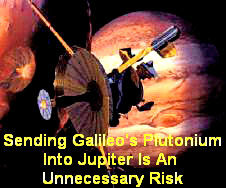 is
pushing it ahead with full steam in what could very well become a
mistake of Titanic proportions for all of humankind. This is because
they will hurl the spent satellite Galileo deep into Jupiter’s
atmosphere to a supposedly ‘safe’ but fiery grave. is
pushing it ahead with full steam in what could very well become a
mistake of Titanic proportions for all of humankind. This is because
they will hurl the spent satellite Galileo deep into Jupiter’s
atmosphere to a supposedly ‘safe’ but fiery grave.
However this planet is not Earth where
our concern has been that Galileo's Plutonium could fill our lungs
with radioactivity were it to reenter our atmosphere. However, this
is not a concern because Galileo will be entering Jupiter’s
atmosphere instead. So what!
Jupiter is the giant catcher of the
Solar system, so why should we be concerned? While it is a giant
catcher, it is also the largest pressure cooker of our solar system
and it could crush Galileo’s 48 pounds of Plutonium.
The result could be a Jovian Nagasaki
with dire consequences for humankind.
The Galileo
Mission
NASA’s Galileo mission is coming to an end. Galileo was launched
back in 1989 from the Space Shuttle Atlantis, its mission was to
explore Jupiter and its
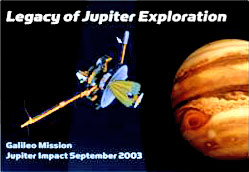 moons.
As September 2003 progresses, the satellite will be maneuvered into
a controlled descent into the atmosphere of Jupiter; there it will
find its grave on September 21, 2003. moons.
As September 2003 progresses, the satellite will be maneuvered into
a controlled descent into the atmosphere of Jupiter; there it will
find its grave on September 21, 2003.
Galileo was sent out to explore Jupiter
and its moons and returned some most interesting results to us.
It found water on the moon
Europa, which has a global ocean under a
thick layer of ice. Because this moon has a good chance of harboring
some primitive life forms, NASA planned the controlled crashing of
Galileo into the atmosphere of Jupiter.
NASA does not want it to accidentally
crash into Europa. Why is such a controlled crash
necessary?
The
Radioisotope Thermal Generator (RTG)
The reason for crashing Galileo into the planet Jupiter on purpose
is this: Galileo since its launch has been powered by Plutonium-238
in a RTG or Radioisotope
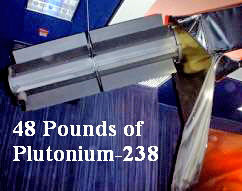 Thermal
Generator. Plutonium-238 decays via alpha and gamma emission, its
daughter products are also highly radioactive for a long time. Thermal
Generator. Plutonium-238 decays via alpha and gamma emission, its
daughter products are also highly radioactive for a long time.
An RTG catches this radiation in a heat
exchanging mechanism and there converts it into electricity.
Duracell doesn’t make batteries like that. These RTG power units can
power a satellite for many years. They powered the Pioneer and
Voyager craft too or they would not have lasted three decades as
they did.
Now, an independent researcher/writer by the name of J.C. Goliathan
gathered some interesting information on the fuel load.
TIPS Report – August, 2003
J.C. Goliathan, July 30, 2003
NUCLEAR REACTION WHEN GALILEO SPACECRAFT IMPACTS INTO JUPITER IN
SEPTEMBER 2003 UNLIKELY, BUT POSSIBLE
The author believes the nuclear events reported here to be very
unlikely and only remotely possible, but just as an asteroid
impact with earth is remotely possible (and widely researched
and reported on), the Jupiter impact issue deserves exposure
also, because there is compelling evidence to suggest the
feasibility of at least a temporary Jupiter ignition.
Given the potential consequences of
this, serious research is warranted. The author is a Geographer
and Engineer, not a physicist. Further research is needed by
more qualified individuals.
While Goliathan’s might be a bit
technical for those outside of his field of study, as a physicist, I
found it to be a brilliant piece of work and so will endeavor to
explain the critical aspects presented in his article in layman’s
terms.
The Concerns
Described in Goliathan’s Article
Theoretically the avalanche reaction described for the Pu-238
pellets aboard Galileo can take place setting off an
implosion-induced nuclear detonation. Literally no one on Earth
knows for certain what will happen when Galileo plunges into
Jupiter. It may even trigger an on-going fusion reaction in the
abundant hydrogen supply of Jupiter, creating a mini-star. We lack
the in-depth knowledge on the atmospheric structure of the planet to
accurately predict the outcome, yet we push ahead on the chosen
path.
Physicists at NASA will undoubtedly tell you the danger is
negligible and try and push this question into the realm of
conspiracy-thinking. As a physicist, I’ve been trained in the safe
application of radiation and I think we need to pay attention here,
as we may be overplaying our hand by ignoring this possibility.
In my work I do risk analysis regularly. In such an analysis I
divide potentially hazardous risks into a matrix. This type of
matrix sorts risks by chance of occurring (on a 1 to 6 scale for
likeliness) on one scale against the severity (on a 1 to 5 scale) on
the other. The product of these two is known as the hazard of the
event. Anything with a product of chance and severity above 12
requires ‘mitigating action’, but special attention is due also for
the highest severity category, regardless of its chance.
This particular risk falls in that category of highest severity, it
has to be looked at. Its chance is minute, but no matter how small
the risk, its consequences are so severe and all-encompassing that
we must not ignore it! I will tell a little more about why they are
so great below.
This Is All
About Plutonium!
Plutonium-238 is a bit of a rogue isotope in the Plutonium family.
It is the “least wanted” of the isotopes of Plutonium for energy
production in nuclear plants or even the use in nuclear bombs. We’ll
go into why that is here.
We start with a schematic buildup of a simple Plutonium implosion
bomb as depicted in the figure below.
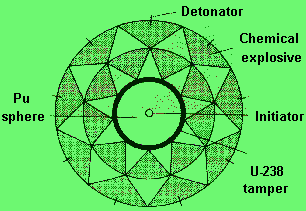
Figure 1: Plutonium
implosion bomb principle
It uses a sphere of a few kilograms of
fissile Plutonium, which is surrounded by a layer of Uranium. Around
that are a few layers of chemical explosive. This schematic is very
important for what the concern among many physicists is about.
Plutonium does have spontaneous fission, I will get back to that
below, it is especially interesting in this particular case. On
fission, atoms fall apart in two or more chunks and a few high
energy neutrons, atom shrapnel really. These neutrons are shot away
in random directions. If they hit other atoms of Plutonium like a
bowling ball hits the pins, these may start splitting as well
because of the impact. In a sphere of only a few pounds these
neutrons don’t encounter enough Plutonium atoms to have enough
chance of breaking one up.
More Plutonium is needed for that.
About plutonium bombs
Critical mass
Critical masses can be calculated quite accurately. The
important parameters are fission cross sections, the average
neutron yield upon fission, and the mass density. The latter
depends heavier on the integrity of the metal lattice than on
the isotopic composition, since mass differences between the
different plutonium isotopes are almost negligible.
Without a neutron reflecting shield, pure Pu-239 metal has a
critical mass of 10 kg , and I have calculated that for a
"reactor grade" isotopic mixture this would be 18 kg. Using a 15
cm U-238 shield, the Pu-239 critical mass is only slightly over
4 kg, while for LWR - produced plutonium (65% thermal fissile
isotopes, fuel burn up around 40 MWd/kg HM) this is some 7 kg.
The critical mass of Plutonium-239 to
start a chain reaction without help is about 10 kilograms. With that
much Plutonium, the chance of a neutron from the middle hitting an
atom on its way out is high enough to keep the reaction going or
even speed it up. Plutonium is easy enough to gather, but you can’t
control an amount like this at all.
That is why in a bomb there is a layer
of Uranium around it, this acts like a neutron mirror, it sends
neutrons right back in for another pass through the Plutonium, only
2 to 4 kilograms of that is necessary this way. That by itself is
still not enough though but keeps the Plutonium from going off by
itself.
If the chemical explosive is set off exactly simultaneously, a
shockwave will travel inward, compressing the Uranium shell and the
Plutonium so far inward that the atoms move much closer together. So
much closer in fact that the two or three neutrons coming out of
every atom splitting up split at least another atom of Plutonium.
The reaction becomes self-sustaining. This principle is the
principle by which a nuclear power plant works. By ‘catching away’
neutrons the balance point of one-splits-one is kept in-tact. The
rest of the free neutrons will crash into water and gives of its
energy boiling the water to steam.
If the shockwaves pushes further in still, then more than one other
atom will be split by the resulting neutrons of an atom splitting
up. An avalanche starts to build. This avalanche creates so much
energy that a counter wave starts pushing outward overcoming the
inward shockwave in an instant. The result is the notorious
mushroom-shaped cloud we all so dread.
Now we get back to the special isotope of Plutonium in use in the
RTGs of Galileo. From the same site there is a table listing the
various isotopes and their (re-)activity.
|
Pu "mixture" |
Pu vector |
Normalized
reactivity |
SF rate
(n/gs) |
|
Pu-239 |
(100%,0,0,0,0) |
1.0 |
0.03 |
|
Pu-240 |
(0,100%,0,0,0) |
0.6 |
1600 |
|
Pu-241 |
(0,0,100%,0,0) |
1.1 |
0 |
|
Pu-242 |
(0,0,0,100%,0) |
0.6 |
1670 |
|
Pu-238 |
(0,0,0,0,100%) |
1.1 |
3440 |
|
Source:
About plutonium bombs |
The 3,440 neutrons per gram per seconds of Pu-238 are the real
reason for concern. If you compare them to the 0.03 neutrons that
spontaneously come out of one gram of Pu-239 it will become obvious
that the critical mass (the mass at which the reaction inside the
Plutonium becomes self sustaining) is much smaller for Pu-238 than
it is for Pu-239. Neutrons travel in every direction, as a result
the difference in SF rate will work in all direction too.
This leads to a critical mass of roughly
200 grams for Pu-238 only. This is why NASA used 144 pellets of 1/3
pounds (151 grams) to get the 48 pounds on board of Galileo. These
pellets are shielded from one another to prevent them from going out
of control. The crucial question is what will happen to these
pellets and their shielding when the satellite plunges into the
atmosphere of Jupiter. Will the shielding hold? Will the pellets
stay together or wander apart? NASA appears to hope they wander
apart or quickly burn up completely (what with, as there is almost
no oxygen to burn them up?).
If the pellets stay together and are compressed ever stronger by the
increasing atmospheric pressure they encounter (they will keep on
falling until the outside specific weight or weight per volume
matches that on the inside!!) each pellet will by itself go beyond
the critical point density and chain-react.
The true danger is if several ones or
all of them were to go supercritical together. In that case you have
48 pounds of Pu-238 going into chain reaction.
Chain Reaction
In the bombing of Nagasaki, the Americans used only 7 kilograms of
Plutonium. 1.2 kilograms of that went into fission, which gave the
explosion a equivalent force of 22 kilotons of TNT.
|
Example/event |
Yield |
Contents |
Fissioned |
|
Hypothetical, LWR Pu |
1-20 kton |
~ 5-7 kg RG Pu |
0.05-1 kg |
|
Trinity test, 1945 |
20 kton |
~ 6 kg WG Pu |
1 kg |
|
Totem I test, 1953 |
12 kton |
~ 80% Pu-fis |
0.7 kg |
|
Hiroshima, 1945 |
12 kton |
~ 50 kg HEU* |
0.7 kg |
|
Nagasaki, 1945 |
22 kton |
~ 7 kg WG Pu |
1.2 kg |
|
Thermonuclear bomb |
~ 1000 kton |
|
|
|
Source:
About plutonium bombs |
Not all of the Plutonium did fission, because after a small part of
it had gone into fission, the outward pressure of that energy
release caused the rest to become spread out, making it go
sub-critical again. If you have a block of Pu-238 sinking into the
atmosphere of Jupiter, the atmosphere will compress it ever
stronger, the outward pressure will have a lot more trouble
overcoming this compression, in the worst case all of the Pu-238
might go into reaction.
If we extrapolate the table above
linearly, about 18-20 ktons are released per kilogram of Plutonium
fully fissioned, then a maximum explosive yield of some 400 ktons
could come from 48 pounds or 21.7 kg of Plutonium.
Not all of the Plutonium will go of course, the explosive energy
will be much lower, but 100 ktons lies well within possibility. In
an explosion of that magnitude, what could be the temperature that
is reached?
"The
world enters the nuclear era"
by Antonino Spoto
Planning, use and consequences of the first atomic bombs.
If in half kilogram of uranium every atom had to split up, the
energy produced will be equal to the explosive power of 10.000
tons of TNT. In this hypothetical case, the efficiency of the
explosion would be of 100%; in the first tests of the A bomb,
this efficiency was never reached. For the detonation of the
atomic bombs have been set more or less sophisticated launchings
systems.
In the simplest system, a bullet of
fissile material is shot against a target of the same material,
in way that the two masses are united in a supercritical whole.
The atomic bomb exploded in Hiroshima on August 6, 1945, was a
weapon of this type, of the power of around 20 kilotons.
A most complex method, said "implosion", is used in a weapon of
spherical conformation. The most external part of the sphere
consists of a layer of lenses of common high potential
explosive, prepared in way to assemble the explosion toward the
center of the bomb (implosion). At the center, there is a core
of fissile material that is compressed to the inside by the
powerful wave of direct pressure; the density of the metal
results increased with consequent production of a supercritical
configuration.
The bomb of the test of Alamogordo
and also that dropped over Nagasaki on August 9 1945, both with
a power of 20 kilotons, they were of the implosion type.
Independently from the method used for getting a supercritical
whole, the chain reaction proceeds for around a millionth of
second, freeing enormous quantities of thermal energy. The so
rapid liberation of such energy in a small volume increases
instantly the temperature to about ten million of degrees.
The rapid expansion and vaporization
of the material that constitutes the bomb gives origin to an
explosion of extreme power.
After only a millionth of a second, the
pressure causing the implosion was overcome above Nagasaki. If such
an explosion were to take place in the Jovian atmosphere instead of
Earth’s, the outside pressure would resist the expansion a lot
longer! The chain reaction could continue longer, up to three times
as long perhaps, as high as 30-50% fission rate could be achieved
instead of 16% and the reaction temperature could shoot up to beyond
100 million degrees.
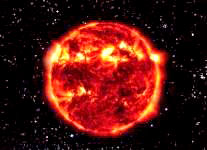 The
threshold temperature for sustained fusion is not as high as that.
The exact conditions for fusion depend on a product of pressure,
temperature and amount of atom nuclei able and ‘willing’ to fuse
together (isotopes of hydrogen with neutrons in them and helium
missing a neutron) into other atom nuclei. The
threshold temperature for sustained fusion is not as high as that.
The exact conditions for fusion depend on a product of pressure,
temperature and amount of atom nuclei able and ‘willing’ to fuse
together (isotopes of hydrogen with neutrons in them and helium
missing a neutron) into other atom nuclei.
The Sun is estimated to have a core temperature of 15 million
degrees. It runs on fusion and the pressure inside amounts to
millions of bars. Chemically, the Sun and Jupiter are not that
different: the Sun also mainly holds hydrogen and helium. The
pressure inside Jupiter will then determine if a fusion reaction can
start up due to a nuclear explosion. If the product of pressure and
temperature and number of fuseable nuclei is reached, a fusion
reaction will start.
The moment fusion starts, all bets are off. There is no telling what
will happen then, if the fusion will sustain itself or fizzle out
again and how long that will take. Is Jupiter heavy enough to keep
the reaction going?
It is not heavy enough to have
spontaneous fusion or we would have a binary star system already,
but 200 ktons may provide the trigger it cannot provide itself.
The Possible
Result of a Jupiter Ignition
If Jupiter ignites, it may throw out a portion of its atmosphere in
a shockwave as most starting stars do. This starting star however
will then be too close for comfort. A portion of that shockwave will
then hit Earth too, its results will be beyond imagination.
Millions of tons of hot hydrogen will
impact the atmosphere hitting it with 1000 km per second. It will
result in an ELE category event at best due to intense global aurora
and a bombardment of X-rays everywhere that may last for days to
weeks. The survivors will be sterile or die from all kinds of
radiation-induced diseases.
After Marshall Masters’ latest article
CONTACT! Canadian Crop Circle Researcher Matt
Rock Identifies the Constellation Pisces as Point of Origin for
English Formations we had one of our many chats on ICQ,
as a bit of discussion, or brainstorming sometimes.
I’ll quote from that chat:
Jacco: I wonder why now, why
now make contact. On the other hand it's logical..
Marshall: We are on the verge of taking weapons into
space. They have to contact us now. This is not optional.
Jacco: Taking weapons into space... no. We're about to
dump a spent nuclear fuel reactor into Jupiter. Without properly
realizing what the consequence may be.
Marshall: Now you've got it. this is a good tie in for
your article.
Jacco: If things really hit the worst scenario, we are
going to f***ing wipe ourselves out this way... Brings to mind
one of the big scenes of T2, the moment before Linda Hamilton
dozes off. The boy and the Terminator are packing and they see a
couple kids playing war... The boy says to the machine:" We're
not going to make it, are we?.."
Marshall: Yes. Now you're seeing something because we now
have the ability to create havoc in the cosmos.
Jacco: Havoc... Kill most life in our Solar system.
Europa would be gone, Mars would be toasted and we'd be on the
verge of extinction ourselves.
It hit both of us almost at the same
time, basically the circles started appearing the moment the Galileo
mission headed on a one way trip to Jupiter back in 1989. It may be
a coincidence, but it is an uncanny one for sure. A logical approach
could be: if you were quietly watching and studying a seemingly
intelligent and self-aware alien life form doing something this
stupid to its environment, would you tell them?
The answer to that may very well be
lying in the crop fields around the world.
NASA Is Taking
an Titanic Risk
Let’s all keep in mind that
NASA has lost two shuttle crews because
of its own internal political problems. This is not an enviable
track record and it would send any commercially viable international
air carrier into immediate bankruptcy. However, NASA does not have
to justify itself to paying customers and stockholders, and so the
void between taxpayers and politically-minded administrators is both
huge and dangerous.
That being said, NASA decision to hurl the spent Galileo spacecraft
along with its plutonium could be the worst. Sending Galileo into an
environment mankind does not know enough about is equal to playing
Russian roulette on a planetary scale. This to me is truly
unbelievable, it should be unacceptable to everyone in the world!
NASA does not know, nor can it know, how long the satellite will
last in the Jovian atmosphere, how high the pressure on the
Plutonium will rise and whether the Plutonium will be crushed
together to form one mass or stay apart in pellets. Still they are
taking the risk of plunging Galileo into Jupiter. There cannot be a
scientific base for it other than guesswork.
So, what if nothing happens. After all the statistics favor NASA’s
decision – for now.
There is only one bullet in the pistol cylinder but if you pull the
trigger often enough, you’ll die, for sure. NASA has pulled the
trigger a few times already , so far nothing happened.
The Plutonium
bullet however may now be up in the chamber. If this goes wrong,
even though the chance of it is remote at best, it will affect all
of us, not just NASA.
|

 is
pushing it ahead with full steam in what could very well become a
mistake of Titanic proportions for all of humankind. This is because
they will hurl the spent satellite Galileo deep into Jupiter’s
atmosphere to a supposedly ‘safe’ but fiery grave.
is
pushing it ahead with full steam in what could very well become a
mistake of Titanic proportions for all of humankind. This is because
they will hurl the spent satellite Galileo deep into Jupiter’s
atmosphere to a supposedly ‘safe’ but fiery grave.  moons.
As September 2003 progresses, the satellite will be maneuvered into
a controlled descent into the atmosphere of Jupiter; there it will
find its grave on September 21, 2003.
moons.
As September 2003 progresses, the satellite will be maneuvered into
a controlled descent into the atmosphere of Jupiter; there it will
find its grave on September 21, 2003.  Thermal
Generator. Plutonium-238 decays via alpha and gamma emission, its
daughter products are also highly radioactive for a long time.
Thermal
Generator. Plutonium-238 decays via alpha and gamma emission, its
daughter products are also highly radioactive for a long time.

 The
threshold temperature for sustained fusion is not as high as that.
The exact conditions for fusion depend on a product of pressure,
temperature and amount of atom nuclei able and ‘willing’ to fuse
together (isotopes of hydrogen with neutrons in them and helium
missing a neutron) into other atom nuclei.
The
threshold temperature for sustained fusion is not as high as that.
The exact conditions for fusion depend on a product of pressure,
temperature and amount of atom nuclei able and ‘willing’ to fuse
together (isotopes of hydrogen with neutrons in them and helium
missing a neutron) into other atom nuclei.